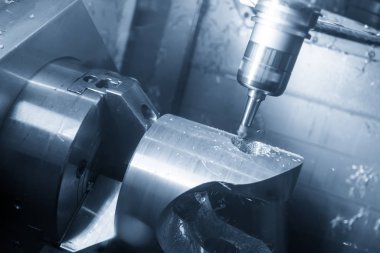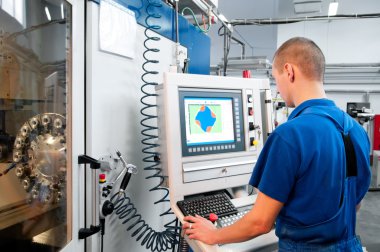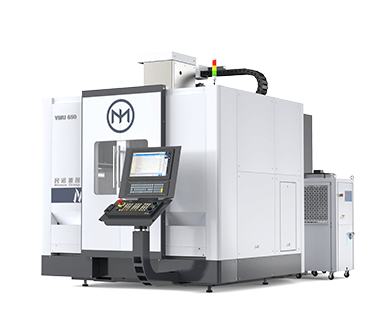In order to ensure the processing accuracy of five-axis CNC machine tools during processing, we use a variety of means such as error compensation, servo system control, full closed-loop control, temperature control and mechanical structure rigidity. In the market, the demand for five-axis machine tools mainly comes from industries such as aerospace, automobile and military industry. It is expected that the global market size will reach 126.98 billion yuan by 2030, with an annual compound growth rate of 10.3%. Despite the high technical barriers in the international market, Chinese companies such as Minnuo Group have made significant progress in this field and have core technologies with independent intellectual property rights.
The five-axis linkage CNC machine tool is a high-tech, high-precision machine tool equipment, mainly used for processing complex surfaces. Its core feature is that it integrates at least five coordinate axes on a machine tool, including three linear coordinates and two rotational coordinates. These coordinate axes can move simultaneously and coordinately for processing under the precise control of the computer numerical control (CNC) system. This coordination ability greatly improves the processing accuracy and efficiency of the machine tool.

At present, we widely regard five-axis CNC machining technology as the sole solution for handling problems in machining continuous, smooth, and complex surfaces.When faced with the difficulties encountered in designing and manufacturing complex surfaces, people often seek the help of five-axis machining technology. However… At present, there are still many difficulties and resistances in five-axis CNC technology.
Five-axis linkage CNC technology represents the most challenging and widely used technology in the field of CNC. It combines computer control, high-efficiency servo drive and fine machining technology, and is specially used for high-efficiency, high-precision and automated machining of complex surfaces.
Now that we have learned some basic aspects about five-axis machine tools, let’s take a look at the advantages of five-axis machine tools.
Processing Complex Surfaces:
Five-axis machines can handle intricate 3D surfaces that are challenging to machine with traditional three-axis machines across many industries.
One-Time Clamping:
Parts can have multiple surfaces machined in a single clamping, reducing the number of clampings and the errors that come with them.
Improved Machining Precision:
With five-axis coordination, tools can approach the workpiece at optimal angles, reducing vibration and machining errors.
Increased Efficiency:
Five-axis machines achieve high efficiency when processing complex parts, cutting down machining time and production cycles.
Reduced Post-Processing:
The high precision of five-axis machines minimizes the need for manual polishing and corrections afterward.
High Tool Utilization:
Tools can cut from any direction, maximizing cutting efficiency.
Optimized Tool Path:
The machine can automatically adjust the tool path to prevent interference between the tool and the workpiece.
Less Tool Wear:
Tools can contact the workpiece at optimal angles, reducing wear caused by improper cutting angles.
Enhanced Surface Quality:
Tools can cut at optimal angles, resulting in better surface finish. Flexibility and adaptability: Five-axis machines can meet changing processing demands, making them suitable for small batch and varied production.
Reduced Machine Quantity:
One five-axis machine can perform the work of multiple three-axis machines, lowering equipment investment.
Shortened Design-to-Production Time:
Five-axis machines can quickly transition from design to production, speeding up time to market.
Suitable for New Materials:
For challenging materials like titanium alloys and composites, five-axis machines can better control the cutting process.
According to the machine tool structure and the layout of the rotating axis, here are some common types of five-axis machine tools:
Vertical Five-Axis Machine Tools:
We vertically mount the spindles on vertical five-axis machines, allowing the worktable to move in three directions. These machines excel at machining large and heavy workpieces, such as molds and aircraft engine components. The vertical design facilitates the discharge of coolant and chips, ensuring rigidity and stability.
Horizontal Five-Axis Machine Tools:
The spindles on horizontal five-axis machines are installed horizontally, with the worktable moving in three directions. Ideal for smaller parts like precision components, the horizontal layout aids in the removal of coolant and chips during machining.
Gantry Five-Axis Machine Tools:
The gantry five-axis machine tool features a bridge that spans the worktable, with the spindle and worktable movements supported by the bridge. This structure effectively enhances the stability and rigidity of the worktable, making it suitable for machining larger and heavier workpieces. It is commonly used in fields such as aerospace and shipbuilding.
Column-Moving Five-Axis Machine Tools:
In this setup, the column is mounted on the worktable and can move along it, offering a larger processing range and flexibility.
Dual-Rotary Table Five-Axis Machine Tools:
We use these machines, which have two rotary axes, for machining complex spatial surfaces
, such as parts in the aerospace industry.
Swing-Head Five-Axis Machine Tools:
Swing-head five-axis machines feature a pivoting head that can rotate around two axes, ideal for machining complex three-dimensional shapes.
One-Swing-One-Rotation Five-Axis Machine Tools:
Combining the features of rotary tables and swing heads, these machines provide flexible machining capabilities.
NC Table + NC Dividing Head:
This machine achieves five-axis machining capabilities through the movement of the table and the rotation of the dividing head.
NC Table + Fixed Angle B-Axis:
In this configuration, the worktable can rotate while the spindle head is at a fixed angle, providing a specific machining angle.
NC Table + Variable Angle A-Axis:
We can rotate the worktable and position the spindle head at various angles,offering a broader range of machining angles.
Two-Axis CNC Spindle:
In this machine, the spindle can rotate around two axes to achieve complex spatial machining.
At present, it is very important for five-axis CNC technology to ensure the accuracy of the processing process. So how do we deal with this technical problem?
First, in order to pre-determine the system errors of the machine tool, we use error compensation techniques for issues like guide wear, rotary axis errors, and tool wear, inputting these values into the control system for compensation, effectively enhancing machining accuracy.
Secondly, applying servo system control technology, including high-performance servo motors, drivers, and feedback devices, ensures that CNC system commands are accurately translated into the machine tool’s actual movements, directly impacting motion precision.
Additionally, a fully closed-loop control system is used, with position measurement devices installed directly on the moving parts of the machine tool, eliminating errors in the transmission chain and improving positioning and repeatability accuracy.
Temperature control is also crucial because thermal deformation can significantly affect machine tool accuracy. Therefore, managing the temperature of the machine tool and its surrounding environment is essential for maintaining machining precision.
To ensure the stability and accuracy of the machine tool, regular maintenance and upkeep are indispensable. Personnel lubricate, clean, and replace necessary parts of the machine tool. Precision inspection and calibration are equally important, with professional equipment like laser interferometers and ball bars used for regular checks and adjustments.
Software optimization is also a key factor in improving accuracy. We use advanced CAM software to optimize cutting paths and reduce machining errors. Training for operators is also crucial; they are well-versed in the performance and characteristics of the equipment and know the correct operation methods.
Lastly, implementing a preventive maintenance plan helps to identify and fix potential issues early, preventing loss of accuracy and ensuring the machine tool remains in optimal working condition for the long term.

Due to the special status of five-axis machine tools, especially their important influence on aviation, aerospace, and military industries, as well as their technical complexity, Western industrialized countries have always implemented an export license system for five-axis CNC systems as strategic materials. Here are some data for market research:
China’s machine tool market is segmented into high-end (10%), mid-range (30%), and low-end (60%). Among these, five-axis CNC machine tools are high-end products that are scarce due to high technical barriers. It is predicted that the global market size for five-axis CNC machine tools will be 64.3 billion yuan in 2023 and is expected to grow to 126.98 billion yuan by 2030, with an annual growth rate of 10.3%. Vertical five-axis machine tools hold the main market share, with aerospace and aviation being their primary application areas.
In the international market, five-axis CNC machine tools are advancing towards technological innovation and intelligence, aiming for high precision and efficiency. As the manufacturing industry upgrades, the market size and application areas are expected to expand. At the same time, the industry will face stricter environmental and safety requirements, promoting green manufacturing and sustainable development.











